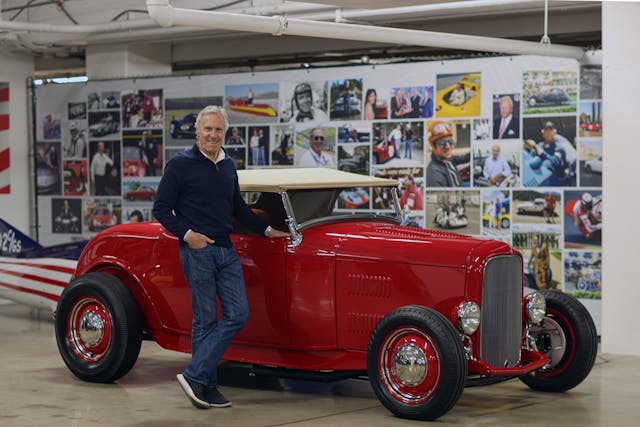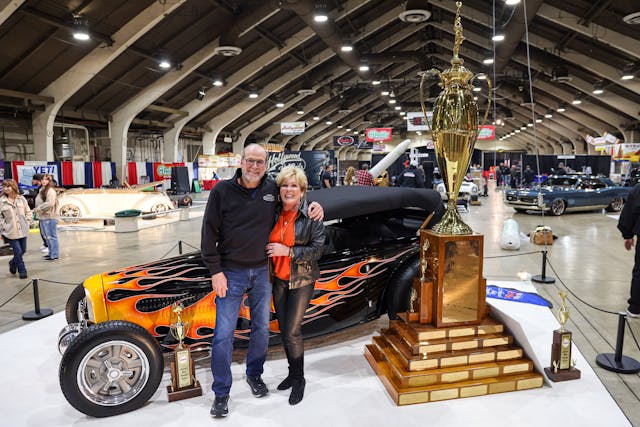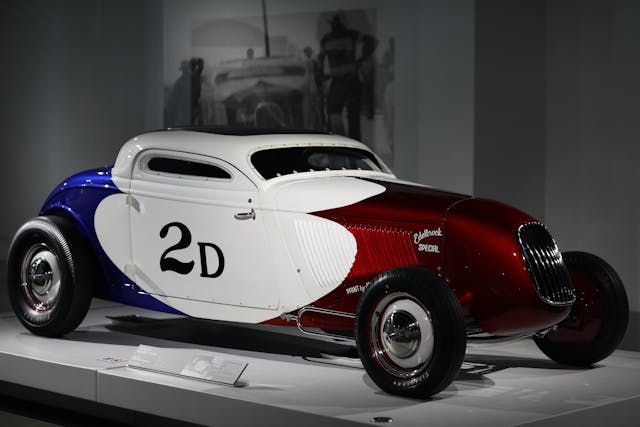Why Hot Rods Are So Difficult to Value
Placing a value on a car can be relatively straightforward when there are plenty of data points and everyone knows exactly what’s on offer. Let’s take one of the most popular collector cars as an example. Ford built a million 1965-1966 Mustangs. Their production is well documented. We know what they looked like when they rolled off the assembly line, and they sell every day. Plotting the data will reveal that certain body styles, options, and even colors impact prices. Valuing rare cars can be more difficult, but people still know a Lamborghini Miura when they see one, and can research what it’s worth based on specs and condition. Hot rods, however, are another animal entirely.
The factory lines, proportions, and drivetrain are only a starting point for hot rods. Countless details are reworked in ways that are subtle and sometimes unique. Original components are often outright discarded. With all the variables in each and every hot rod, how can one possibly figure out how much one is worth?

To help us sort things out, we spoke with Terry Karges, Director of the Petersen Automotive Museum, via phone. We also visited Bruce Meyer, one of the nation’s top sports car and hot rod collectors, who wrote the book on ’32 Ford hot rods based on his own extensive collection.
Karges explained how difficult it can be to even begin to put a price tag on a custom-built car. “Hot rods are one-off creations,” said Karges. “You’ve got old-school T-buckets, Brizio hot rods that are the cleanest of the clean, and Ringbrothers builds that are wildly imaginative.” They all fall under the banner of “hot rod”, but each bring with them different qualities.
Provenance
Just like any other modified performance machine, a hot rod’s build history, ownership lineage, and race pedigree all factor into its value. “Sophisticated buyers have their favorite builder,” Karges said. Some car builders have a few well-heeled repeat customers who have kept the lights on. Some buyers, like George Poteet, keep going back to the same couple of high-end shops and have multiple irons in the fire at a time.
“I’m a huge fan of Roy Brizio.” Meyer explained, noting that when Roy Brizio builds a car the customer wants, he’ll also steer them to make choices that won’t spoil the overall aesthetic. “I’ve been involved with a lot of hot rods. So few of them really run down the road right. With Brizio, it’s gonna run down the road right.” A builder’s reputation, then, carries weight.

So does a major award. There are more than 30 major hot rod shows across the nation each year, including the Detroit Autorama and the Grand National Roadster Show that crown the Ridler Award and America’s Most Beautiful Roadster, respectively. Any car that’s won an award with such discerning judges has got to have the basic proportions dialed in and have stellar build quality that stands out from the crowd. “Winning a show would always add value,” said Karges. “If you like a car, and it has provenance, and it was owned by a well-known collector or won a show, that certainly helps.”
The Look
Hot-rodding evolved from Southern California land-speed racing, as street cars emulated the chopped, fenderless race cars that plied the dry lakes of the high desert. Form followed function. Stripped-down, lowered cars built to reduce weight and drag can also look phenomenal. Enzo Ferrari famously said, “Race cars are neither beautiful nor ugly. They become beautiful when they win”. Bruce Meyer would disagree. As important as the car’s history, aesthetics play a major role in whether or not a car makes it into Meyer’s collection. “For me, the car has to look good,” Meyer said. “When I started doing this, back 30 years ago, hot rods were of no use to anybody. They weren’t a lot of money. I just went through Hot Rod Magazine and I picked out what I thought were the best-looking cars. That’s kind of how I started.”
Meyer found the cars that were considered noteworthy then, that also appealed to him when he was a kid, and tracked them down. “The most important thing to me is the aesthetic.” Meyer would often have owners trying to sell him cars that had been race winners, but contrary to Enzo’s words, they didn’t appeal on their race pedigree alone. They didn’t make the cut.

“The Greer, Black, Prudhomme dragster is one of the most famous in the world,” Meyer noted, alluding to its phenomenal win/loss record and launching the racing career of Don Prudhomme. “It looked good in my eyes.” In a time of long, spindly dragsters with bodywork that was often an afterthought, the short (for a dragster) sculpted body, painted by Prudhomme himself, caught Meyer’s attention. After its restoration, the dragster served as a cackle car for years with its overbored Chrysler 392 Hemi and a reproduction of its signature scoop.
Restored vs. Preserved
Meyer’s current tilt toward preservation is penance for all the cars he modified in the 1980s. “I wanted everything red with a tan interior,” Meyer said. “I took a beautiful, original, 300SL gullwing, changed the color, and took out the original interior. It’s sad, but that’s what happened. Lately, if it can be saved, I save it. That’s the trend today.”

Just like their road-racing brethren, drag cars and land-speed cars were not held in much esteem when they were no longer competitive. Hot rods built for the street or for show often suffer from a similar fate. Years of neglect can mean extensive deterioration and a need for repairs, but that’s often the only option. Restoring a car with a long history of modifications can also bring a different set of challenges with hot rods. “You have to pick a point in time you restore a car to,” Meyer said “Like the McGee car. That car went from Bob McGee to Dick Stritchfield. Scritchfield was the founder of the LA Roadsters. He did more famous stuff with the car than McGee did, but McGee was on the cover of Hot Rod Magazine with the car in 1948, the first year of Hot Rod Magazine.” Meyer fell in love with the car as a kid. The early iteration, McGee’s vision for the car, struck him. “Then Stritchfield got it, put a Chevy in it, and put headers on it. It was probably in 10 movies. Then he took it to Bonneville and set a record.” When Meyer finally had the opportunity to buy the car, Stritchfield thought that it might get restored to its ‘50s Hollywood heyday. Instead, Meyer brought it back to its 1948 glory, as it was on Hot Rod’s cover.
Meyer has been asked why he didn’t restore CXS2001, the first Shelby Cobra, to how it was when it left Shelby’s Venice shop. Meyer likened the proposition of undoing all of the history of the car to turning the Doane Spencer Roadster or the McGee Roadster back into run-of-the-mill ’32 Fords with factory parts and proportions. “That’s what’s really important, finding that point in time and being true to it, said Meyer. “It’s got to be really good looking, owned by somebody great, done something great, important in the period, and then I restore it back to that moment in time.”

Meyer told us about another example of modifying a car that slightly deviates from his current philosophy. Bob Morris tried to buy the Doane Spencer car, but Doane had already planned on selling it to Meyer. Morris decided to build a gorgeous homage to the Doan Spencer car and spared no expense.

Years after it was built, Meyer purchased the car for himself. As fantastic as the car was, Meyer thought there were some improvements to be made. He explained that when looking at the car from the rear, the wheels stuck out a bit too much. “The wheels were just outboard, like outriggers. So we tucked them in a little bit. The exhaust system was nothing special, so we put a proper exhaust system on it. It needed stagger, so we left 15s on the front and put 17s on the back.” None of the changes were major. They weren’t permanent, “nobody would even know but me,” Meyer said. The modifications did come back to haunt Meyer, however. The Pebble Beach Concours d’Elegance had a class of Hot Rod Magazine “cover cars” in 2019. “I was so proud of what we did to that car, and I was telling the judges how we tweaked this and added a little. They said, ‘Bruce, we appreciate that, but we’re looking for original, as it was on the cover.’ I didn’t win a prize, for all the right reasons.”
Collecting vs. Investing
This was another topic where Meyer and Karges agreed. High-end custom builds can take a year or more and involve scores of talented craftsmen. “Is that car worth what it cost to build after it’s done? Probably not,” said Karges, referring to top-notch custom work. “People who have them built don’t plan on selling them.” Many of the vintage hot rod builds donated to the Petersen Museum collection come from estates after the owner has passed.
“Hot rods, generally, have not been a great investment,” said Meyer. He’s spent considerable time and money restoring historically significant hot rods like the So-Cal belly tanker and the aforementioned Greer-Black-Prudhomme dragster. The Pierson Bros coupe is another that required a major restoration.

“It’s still a labor of love,” said Karges. “You not going to be able to restore a car and get what you put into it.” That applies to restorations of all kinds, not just hot rods. Still, it’s tough to put a price on history. We have to agree with Karges’ sentiment when considering acquiring a hot rod for a collection, “How many Delahayes can you have?”
***
Check out the Hagerty Media homepage so you don’t miss a single story, or better yet, bookmark it. To get our best stories delivered right to your inbox, subscribe to our newsletters.



Well here is my take.
Some collectors only buy hot rods that are well known, historic and represent the era they are from. Bruce Myers’s cars are an example.
Some are builders who like buying from fame present day builders trying to set a trend. Billy Gibbions cars are an example.
Then there are the average buyers and builders. The dumb ones buy and often have no idea what they are buying. Others are smart and shop for cars that are well documented in their builds. They are often as good as the big names but more affordable.
The final is race cars. These often depend on history, record and driver. Some can be chosen for who drove them, some their recorded wins and others for their tech. They can be a perfect GTO to an imperfect old yeller race car.
Take a NASCAR stock car. They can be the same but a Goodwrench cat driven by Dale can go six figures while a no name driver with a lesser sponsor can be $15,000
As in property they say location cars like this is quality and history.
As for restored or preserved, it depends on the cars condition and present state. If it still looks good and is in the condition it was known for preserve. If it is like the So Cal tanker, primer and in the rafters not a hint of the original car you restore.
Hot rods are a personal choice on what one wants and likes. I’d buy one to drive not worry about turning into my retirement fund.
While I understand the appeal of going to a shop for a top quality piece I still find myself appreciating those garage built cars more so. It harks back to the beginning of hot rodding , kind of a time capsule.Those guys were hunting through junkyards for parts, mixing and matching, going to the local hardware store to find what they could make work. Making it up as they went along innovating, learning by trial and error. Then saving up to buy a nail head intake from Honest Charlie’s or bartering with a buddy to do some welding. As such there were all sorts of combinations used and an appeal in that variety too. Your classic old school hot rod is simple enough that you can see the quality of work and attention to detail or not if you just look hard enough, even if its been driven hard. Old vintage race cars are another subject and another thing all together. Prudhommes dragster may have its roots in hot rodding, but I can’t imagine he was driving it home after running at Lion’s.
I have my father’s slightly rodded 34 Ford Tudor that he gave me when he couldn’t drive it any more. It was in bad shape, so I backed up a truck full of cash at my mechanic’s shop and dumped it with him to give it street modern drive-ability and a sweet new paint job and interior. I now realize I can only get a quarter of that money back, but the fun, the looks and the memory of my dad is all worth it.
hyperv6 doesn’t seem to understand that the VAST majority of hot rods have been built by regular people, not name brand shops. Of all my many hot rod buddies over the years, only 2 of them have had a specialty shop build their hot rods. The rest have been built in our garages by us with help from our friends, and the documentation is probably non-existent except for our knowledge of the car’s history in our community of hot rodders. Every hot rod is unique, more so for those that were built “back in the day” before “1-800” parts sources existed. Yes, there are some really badly executed hot rod builds and any potential buyer needs to inspect a car before it is purchased, and know what they are looking at, good and bad. Additionally, a hot rod is never finished, as new products and tastes change over time, as well as the need to make improvements for performance and safety.
The title of the article is correct – hot rods are truly difficult to value, for many reasons. Not the least of which are the different levels of build quality, finish, age, styling, personal taste, and condition of the car. Nothing can replace inspecting the hot rod with full knowledge of what you are looking at from the standpoint of design and construction quality and safety, parts used, wear & tear, as well as cohesiveness of the design and quality of fit and finish. I have currently 3 hot rods. One I built in the early ’70s and still drive, although it has been upgraded several times over the years to take advantage of improved suspension and drivetrain advances. The other 2 are ’33 roadsters. One is a build project from the ground up. I currently have almost $50k in purchased items and over 700 build hours in the car, with an estimated additional $50-$60k of purchased and contracted items needed to complete the car. The other is a “finished” car that I bought for less than it would take me to finish the “project” roadster. Although a running/driving car when I purchased it, it was “needy” and required 7 months of part time effort and additional costs to bring it up to what I consider a safe and reliable driver. Even so, the cost to purchase a good running hot rod is significantly less than the cost to build or have a hot rod built. I sympathize with the article’s title. There is no blue book price for a hot rod, only a passion price. As the old advertisement said: “When you turn your car on, does it return the favor?” And as another old sage has said: “Buyer Beware”.
Tend to agree with you here. I feel like his comment added anything meaningful to the conversation and was more trying to get coattail attention on an otherwise well written article. I don’t think it added anything meaningful.
He comes from a different perspective. He’s from a GM family and works in the industry. Buying is often the choice for those folks. Nothing wrong with it, just the way it is.
I build all my stuff. Be it customs or restorations. I build them the way I want them. My stuff is an investment in enjoyment and relaxation. I invest my money with a professional who has done better over the last 30 years than the collector car market.
Bottom line – do what YOU like, plenty of folks with try to defecate upon your dreams, don’t let them.
I completely agree with Meyers on his ideas. It is with great gratitude that I saw thank you to Bruce for preserving so many of these cars not to mention influencing others to do the same. All of the points made are true as stated and the history is so important. I’ve always loved the McGee car in it’s original configuration as the quintessential ’32 Ford. I would add her the ’32 that was much loved and owned by journalist Grey Baskerville. It is an iconic image that almost any hot rod fan would recognize and it was just perfect, Primer and all. Another one that has been preserved as it was known for decades. It’s kind of ironic that after many years the people that loved to cut, chop, shave channel etc. without a thought to preservation, now love the fact that some of the most fondly remembered chopped and channeled rods or our own memories are being preserved.